Missouri
-
- US Inland Waterways: Looking for Rainmakers Marine News, Nov 2022 #34
As 2022 moves into its final months, low water levels and drought form the basis of the news impacting inland waterways operators and barge companies. In the first week of October, numerous barges were reported grounded in the Mississippi River, particularly south of Baton Rouge. This has consequences: barge rates jumped 218% in St. Louis, compared to 2021.
Low water was so severe that on October 7 Ingram Barge CEO John Roberts issued a force majeure notice (force majeure - unforeseeable circumstances that prevent someone from fulfilling a contract).
“Chronic low water conditions throughout the inland river system have had a negative effect on many who rely on the river, including Ingram Barge. We informed customers yesterday that given the difficult operating conditions posed by this low water, we were providing formal notice of a force majeure event—namely that circumstances out of our control were preventing normal river transport operations in certain areas. We want to emphasize that this only affects a limited part of our operating network—points below Baton Rouge, La. We anticipate that available barge supply in the affected area will improve in the coming days."
 “We informed customers [October 6] that given the difficult operating conditions posed by this low water, we were providing formal notice of a force majeure event—namely that circumstances out of our control were preventing normal river transport operations in certain areas.” - John Roberts, Ingram Barge Company President & CEO. (Photo: Ingram Barge Company)
“We informed customers [October 6] that given the difficult operating conditions posed by this low water, we were providing formal notice of a force majeure event—namely that circumstances out of our control were preventing normal river transport operations in certain areas.” - John Roberts, Ingram Barge Company President & CEO. (Photo: Ingram Barge Company)Forecasts were grim. Extended streamflow predictions from the National Weather Service (NWS) showed nothing but declines through the first week of November for the lower Mississippi from Cape Girardeau to New Orleans.
Jeff Graschel is a hydrologist with the NWS Lower Mississippi River Forecast Center. He said that based on the center’s 28-day forecasts water levels this year could reach the extremely low levels experienced in 2012. Graschel said that hurricane Ian poured a lot of water into eastern portions of the Ohio River system. After the first week in October that water was reaching Cairo, Ill. Graschel said it then takes about 10 days for water from Cairo to reach New Orleans. However, even from a hurricane, this is just a drop in the proverbial bucket, not a replacement for normal rainfall events.
Graschel was asked about reservoirs and when and how they contribute to river levels. He explained that dams and reservoirs on tributaries are regulated locally, not for the system as a whole. He said the Corp of Engineers (COE) decides how much water can be released, an analysis that includes factors beyond navigation, such as electricity generation, agriculture, drinking water and recreation.
NWS provides data for Reservoir Water Supply Information. In relatively northern reservoirs, e.g., in Kentucky and Tennessee, water levels are high but, again, that status doesn’t directly impact release rates and volumes and, eventually, the lower Mississippi. Water levels on other waterways, such as the Tennessee system, were at targeted channel depths. However, the scale of those operations does not match the Mississippi, which is particularly critical during harvest season.
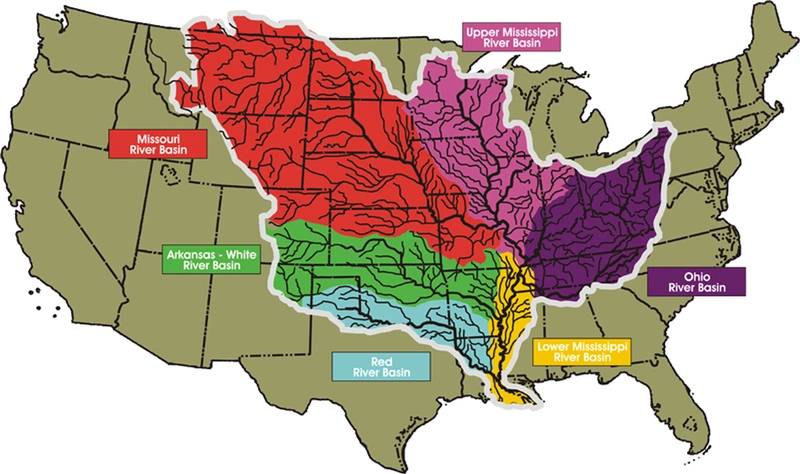 (Image: Mississippi River Commission)
(Image: Mississippi River Commission)Missouri River draft AOP
As this article goes to press water policy issues are in the planning stage within the Missouri River Water Management Division which is developing its 2022-2023 Annual Operating Plan (AOP) for the 2,341 miles long Missouri, which flows into the Mississippi at St. Louis (the Missouri is the longest river on the continent; about 100 miles longer than the Mississippi). The Missouri Division and the Columbia River Basin are unique in developing AOPs because they control dam operations. Other ACE units have oversight roles but not operational ones. The Missouri Division operates the six mainstem dams on the Missouri River.The Corps’ Draft AOP was released in September. Public meetings are scheduled October 24 through the 27th, written comments will be accepted until November 23. The plan presents modeled release rates depending on varying rainfall and runoff estimates. It presents how navigation releases will be balanced against other demands. And it lists the seasonal decision dates when these actions will be taken.
Coincidentally, in early October, ACE announced worsening drought conditions in the upper Missouri.
September runoff above Sioux City, Iowa was 0.6 million acre-feet (MAF), 47% of the long-term average. Soil conditions were very dry. The Drought Mitigation Center reported that over 90% of the Missouri basin was experiencing some form of abnormally dry conditions or drought, almost a 20% increase from the end of August.
“Runoff in the upper Missouri River Basin was below average during the month of September and is expected to remain low throughout the rest of 2022,” said John Remus, chief of the U.S. Army Corps of Engineers’ Missouri River Basin Water Management Division. The 2022 calendar year runoff forecast for the upper Basin, updated on Oct. 1, was 19.5 MAF, 76% of average and 0.7 MAF lower than the prior month’s annual runoff forecast. Average annual runoff for the upper Basin is 25.7 MAF.
For navigation, USACE wrote that Gavins Point Dam releases will be set to provide navigation flow support at a level 500 cfs above minimum service at all four target locations (Sioux City, Omaha, Nebraska City and Kansas City). Season support will end on November 28 at the mouth of the Missouri River. USACE writes that “releases will be adjusted as necessary to meet all downstream navigation targets.”
Release rates at other dams will drop. Consider:
- At Big Bend Dam last month’s releases were 28,900 cfs. Forecast rate is 19,500 cfs.
- Oahe Dam drops from 29,100 cfs last month to a forecast of 20,300.
- Fort Peck drops from 7700 to 4000 cfs.
The Corps’ notice includes this caution:
“The forecast reservoir releases and elevations discussed above are not definitive. Additional precipitation, lack of precipitation or other circumstances could cause adjustments to the reservoir release rates.”
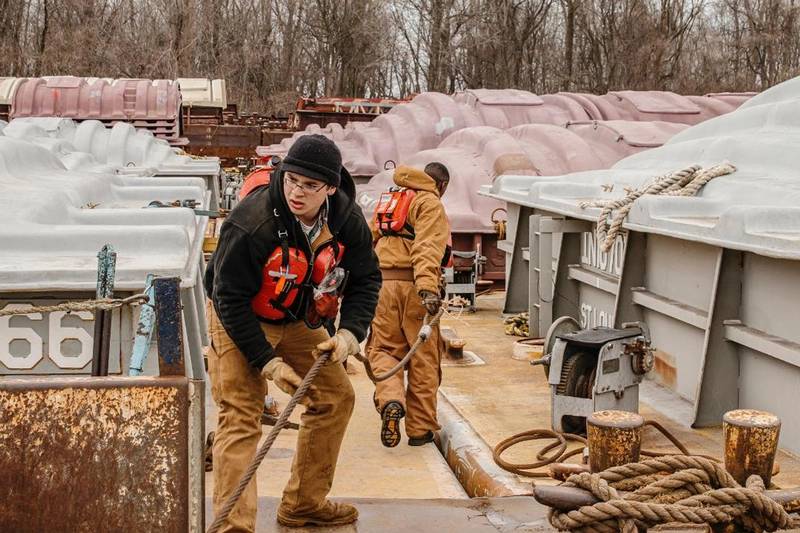 (Photo: Ingram Barge Company)
(Photo: Ingram Barge Company)Food: national impacts
Mike Steenhoek, Executive Director of the Soy Transportation Coalition based in Ankeny, Iowa, keeps a close eye on the inland waterways, particularly the Mississippi. In early October, Steenhoek commented that "conditions continue to deteriorate due to historically low water." He added, "The strength of U.S. soybean exports and the condition of the inland waterway system are closely interconnected."Channel depth and width limits are impacting agricultural economics at an inopportune time, Steenhoek said. Barge transportation is essential: 80% of ag exports occur between September and February; 54% of soybean exports depend on barges.
Steenhoek said that, because of low water, barge and towing companies have set a 25-barge maximum tow south of St. Louis, a limit that contrasts with 30-40 barges under normal conditions. Because total capacity has decreased there is demand for more barges, plus crews and towboats, to transport the 2022 harvest. Rates have skyrocketed. Steenhoek cited U.S. DOA statistics: On 10/4 the cost to transport a ton of soybeans from St. Louis was $90.45. In 2021, the same shipment cost $28.45, a 218% increase.
This slams farmers because the price a farmer receives at point of sale is influenced by how efficiently, or not, agricultural products clear the market. Supply chain problems cause transactions to confront a "negative basis," i.e., when a storage facility can't move product out it pays less for product coming in - from the farmers. As examples, Steenhoek cited the following:
•In Aurora, Ind., (near Cincinnati): negative soybean basis was $1.29. Normal negative is $0.35-$0.40. Negative corn basis was $1.02; normal is $0.25-$0.35.
•In Davenport, Iowa, negative soybean basis was $0.90; normal is $0.30 to $0.45. For corn, negative was $0.30; normal negative is $0.20.
•Near Memphis: negative soybean basis was $1.15; same as last year. For corn negative was $0.75; normal at this time of year is even to negative $0.20.
Operators’ interests
Lynn M. Muench is Senior Vice President – Regional Advocacy for the American Waterways Operators (AWO); she is based in St. Louis. Muench was asked about the Missouri River AOP, whether AWO participates in that planning process. “Absolutely,” she said. “We’ve been engaged in that process for the last 23 years.” She said AOP development was critical, not just for the Missouri River but also for the middle Mississippi. “We look to maximize flows,” she explained.This advocacy works within a larger coalition, which Muench chairs, including agricultural groups and farming interests. One goal is encouraging the USACE to complete its plan by the end of December. That timing allows river operators to look ahead at likely conditions and plan accordingly, both for operations and rates. This partnership has supported increased funding to maintain Missouri River navigation.
Muench added that new federal waterways infrastructure spending “is really going to be huge,” i.e., hugely beneficial. She specifically cited benefits from redundant locks—one lock failure won’t shut down the river. Transport efficiencies will go way up, as will the green profile for waterways shipping. “We won’t be stopping and waiting, taking tows apart and putting them back together,” she pointed out. “We’re going to keep moving.”
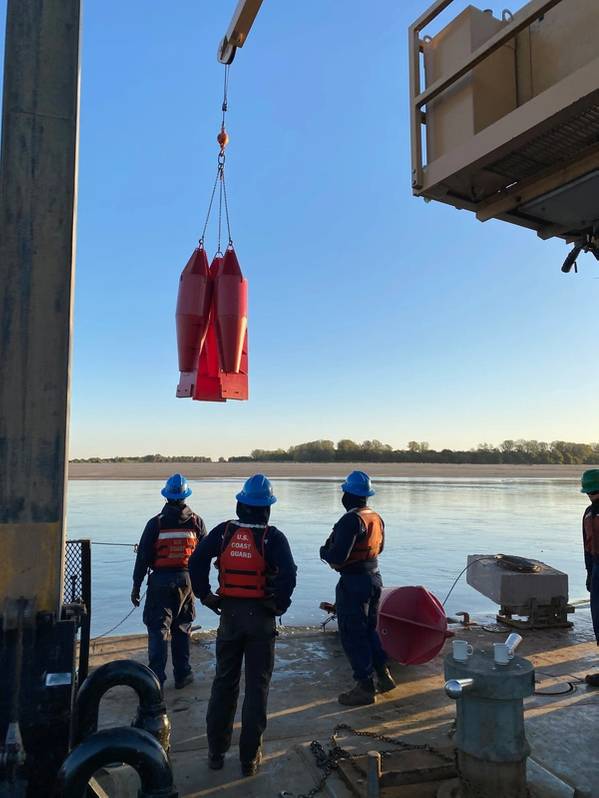 Coast Guard Cutter Chena provides aid to navigation on the Lower Mississippi River on October 13, 2022. The Coast Guard, U.S. Army Corps of Engineers and industry partners are working together to ensure navigational safety and minimize interruptions to the flow of commerce along the Mississippi River. (Photo: U.S. Coast Guard)
Coast Guard Cutter Chena provides aid to navigation on the Lower Mississippi River on October 13, 2022. The Coast Guard, U.S. Army Corps of Engineers and industry partners are working together to ensure navigational safety and minimize interruptions to the flow of commerce along the Mississippi River. (Photo: U.S. Coast Guard)“We need rain”
In August, the Mississippi River Commission (MRC) conducted its annual low-water inspection trip on the River, holding four public meetings in Tennessee, Mississippi and Louisiana. Charles Camillo is MRC’s Executive Director. He said these meetings have been held since 1882. The seven-member Commission was established in 1879. Its mission: “to develop plans to improve the condition of the Mississippi River, foster navigation, promote commerce and prevent destructive floods.”Camillo said about 200 people attended the low-water meetings this year, a number rebounding after COVID. Most people attending represent groups linked to the river’s operations, such as ports and related associations and businesses. About 70 people provided testimony which is reviewed by the Commission and then presented to the Army Corps with advisories for follow up.
Regarding the drought and low water, Camillo commented that he would rather fight a flood than a drought since options are so limited. No one can control the weather, and he added that ports and waterway officials will continue to do what they can, e.g., dredging, scouring and maintaining dikes.
Camillo said that many comments this year were “a thank you” to federal officials for supporting infrastructure money. Local officials noted that money for dredging allowed ports to stay open, despite low water challenges.
Lisa Parker is Director of Public Affairs, Mississippi Valley Division, U.S. Army Corps of Engineers. Parker said the Corps is confident it can maintain 9-foot navigation throughout the system. All Corps’ dredges are engaged and ready to respond, she said.
She noted that flood control projects on tributaries are proceeding with regular winter pool drawdowns. “This flow augmentation,” she said, “off of the Ohio and Missouri Rivers, along with other smaller tributaries, is helping the low flow situation on the lower Mississippi River at least through October.”
Still, the situation could worsen, and the Corps is considering delaying some winter drawdowns for release if conditions become critical.
“The last time we experienced conditions like this was in 2012,” Parker said. “The bottom line is, we need rain.”
-
- Conrad Industries Delivers Floating Drydock For Use At New Missouri Repair Yard Maritime Reporter, Apr 1989 #98
, Inc., Morgan City, La., has arrived for service in St. Louis, Mo. Conrad Industries' CEO, J. Parker Conrad, said the unit, which was contracted for by Missouri Drydock and Repair Company, Cape Giradeau, Mo., is being used primarily to drydock river pushboats. This vessel, measuring 180 by 78 feet, is unique
-
- Cummins-Powered Excursion Boat 'Missouri River Queen' Delivered By Marine Builders Maritime Reporter, Jul 16, 1985 #8
Marine Builders, Inc. of Utica, Ind., recently launched the Missouri River Queen (shown above), a 95- foot paddlewheel excursion boat with a 31-foot beam, 6'/2-foot depth, 3'4-foot draft and a '/-inch steel hull. The 600-passenger vessel was delivered to Richard Lynn of Kansas City, Mo., where plans
-
- The Iowa Class Battleships Maritime Reporter, Apr 1991 #50
last battleships built by the United States. In addition to the U.S.S. Iowa (BB-61), the class includes the U.S.S. New Jersey (BB- 62), the U.S.S. Missouri (BB-63), and the U.S.S. Wisconsin (BB-64). The ships were originally commissioned between 1943 and 1944, were in active status during both World War
-
- Cummins Diesels Power Cruise Vessel 'America' Delivered By Marine Builders Maritime Reporter, Jul 1990 #56
River City U.S.A., Inc., the Kansas City, Kan., operators of the Cummins NTA-855-M-powered paddle-wheeler Missouri River Queen, recently took delivery of a second passenger vessel, the new 150-foot, 800-passenger America. Built by Marine Builders, Inc. of Utica, Ind. (also the builder of the Missouri
-
- GM-Powered Towboat 'Trotter' Delivered By Hudson Shipbuilders Maritime Reporter, Apr 15, 1981 #46
Hudson Shipbuilders, Inc. (HUDSHIP), Pascagoula, Miss., recently delivered the 70-foot towboat Trotter (shown above) to Missouri River Barge Lines of St. Louis, Mo. The vessel is HUDSHTP's standard 70-foot towboat design and represents the yard's continued diversification in the ever-changing
-
- Port Of St. Louis Propeller Club Elects Robert Patrick Maritime Reporter, Oct 1977 #54
is made up of persons engaged in the maritime industry and related businesses. Mr. Patrick succeeds William M. Gardner of Frank B. Hall & Co. of Missouri, Inc., as president of the St. Louis Club. Other elected officers are: vice president, James V. Swift, The Waterways Journal, business manager
-
- Kent E. Hoffmeister Named Engineering VP At Nashville Bridge Maritime Reporter, Jan 15, 1974 #24
engineering. Nabrico is a division of The American Ship Building Company. Mr. Hoffmeister received his bachelor of science degree from Southeast Missouri State University in 1961, where he was a member of the Tau Kappa Epsilon fraternity. His marine experience started at the Missouri Dry Dock and
-
- Battleship New Jersey Is Recommissioned Maritime Reporter, Jan 15, 1983 #16
New Jersey. The U.S. Navy plans to modernize and bring four battleships back into service. These include the USS New Jersey, the USS Iowa, the USS Missouri, and the USS Wisconsin. The first modernization, the USS New Jersey, is now completed at a cost of approximately $326-million. Modernization
-
- Two Appointments Announced By Marathon Marine Maritime Reporter, Jul 1984 #6
engineer from 1981 until his more recent appointment as chief structural engineer. He holds a B.S. degree in Civil Engineering from the University of Missouri- Rolla and a M.S. degree in Civil Engineering from the University of Houston
-
- Delta Line Appoints World Shipping As Midwest Agents Maritime Reporter, Apr 1981 #10
sales and marketing responsibilities on behalf of Delta Line in the states of Illinois, Wisconsin, Minnesota, North and South Dakota, Iowa, and Missouri. Irvin Bedrava, formerly Delta's Chicago office manager, has been retained by Delta as its senior sales executive for the region, and will continue
-
- General Morris Named President Of National Waterways Foundation Maritime Reporter, Aug 1981 #64
more than f o u r years, capping a distinguished 37-year career in this branch of the Army. His assignments included that of Tulsa District Engineer, Missouri River Division Engineer, and Director of Civil Works
-
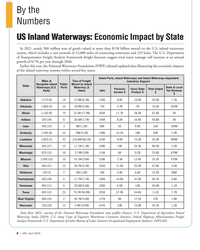 )
April 2024 - Marine News page: 8
)
April 2024 - Marine News page: 82,820 (2)32216.6M (60.1B)143K9.4B15.3B42.2B989M Minnesota 260 (27)1011.1M (1.3B)198K15B24.3B48.5B2.2B Mississippi 870 (12)1617.9M (10B)114K6B9.2B23.8B879M Missouri 1,050 (10)1641.5M (2.6B)128K7.3B13.4B35.2B570M Ohio 440 (21)1029.7M (5.2B)162K11.4B25.2B57.6B3.2B Oklahoma 150 (3)25M (1.6B)78K4.4B6.6B15.5B86M Pennsylvani
-
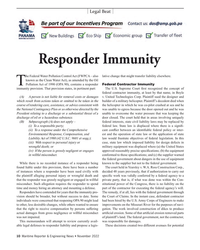 )
November 2022 - Maritime Reporter and Engineering News page: 10
)
November 2022 - Maritime Reporter and Engineering News page: 10lead had been hired by the U.S. Army Corps of Engineers to make to other, less desirable changes, while others wanted to ensure improvements on the Missouri River for the purposes of navi- that the right to receive compensation by persons suffering gation. The work involved construction of dikes to produce
-
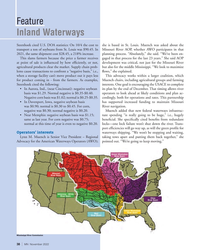 )
November 2022 - Marine News page: 38
)
November 2022 - Marine News page: 38.S. DOA statistics: On 10/4 the cost to she is based in St. Louis. Muench was asked about the transport a ton of soybeans from St. Louis was $90.45. In Missouri River AOP, whether AWO participates in that 2021, the same shipment cost $28.45, a 218% increase. planning process. “Absolutely,” she said. “We’ve
-
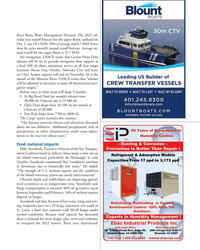 )
November 2022 - Marine News page: 37
)
November 2022 - Marine News page: 37service at all four target locations (Sioux City, Omaha, Nebraska City and Kan- sas City). Season support will end on November 28 at the mouth of the Missouri River. USACE writes that “releases will be adjusted as necessary to meet all downstream navi- gation targets.” Release rates at other dams will drop
-
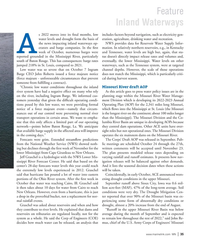 )
November 2022 - Marine News page: 35
)
November 2022 - Marine News page: 35circumstances that prevent cal during harvest season. someone from ful? lling a contract). “Chronic low water conditions throughout the inland Missouri River draft AOP river system have had a negative effect on many who rely As this article goes to press water policy issues are in the on the river
-
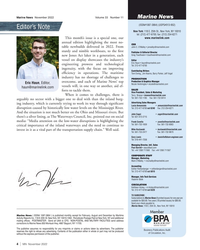 )
November 2022 - Marine News page: 4
)
November 2022 - Marine News page: 4low water levels on the Mississippi River. Tel: 212-477-6700 ext 6240 Fax: 212-254-6271 And the situation is not much better on the Ohio and Missouri rivers. But John Cagni • [email protected] there’s a silver lining, as The Waterways Council, Inc. pointed out on social Tel:
-
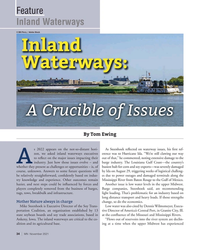 )
November 2021 - Marine News page: 34
)
November 2021 - Marine News page: 3413 tive Director of America’s Central Port, in Granite City, Ill. state soybean boards and soy trade associations, based in at the con? uence of the Missouri and Mississippi Rivers. Ankeny, Iowa. The inland waterways are critical to the co- “Flows out of reservoirs into the river system are declin- alition
-
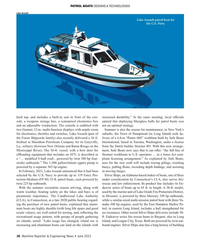 )
June 2021 - Maritime Reporter and Engineering News page: 36
)
June 2021 - Maritime Reporter and Engineering News page: 36on the lakes and bays is of used by the marine unit of Lake Ozark Fire Protection District, paramount importance. The Candlewood Lake Authority in Missouri, is powered by three Mercury 350 hp outboards, (CLA), in Connecticut, at a late 2020 public hearing regard- while a similar-sized multi-mission patrol
-
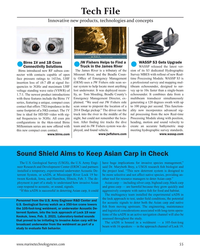 )
May 2021 - Marine Technology Reporter page: 55
)
May 2021 - Marine Technology Reporter page: 55Birns introduced new RF subsea con- The James River is a tributary of the sion of its S3 dedicated Hydrographic nector with contacts capable of open Missouri River, and the Beadle Coun- Survey MBES with rollout of new Real- face pressure ratings to 1433m, UHF ty Of? ce of Emergency Management time Processing
-
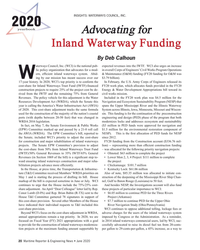 )
June 2020 - Maritime Reporter and Engineering News page: 20
)
June 2020 - Maritime Reporter and Engineering News page: 20Upper Mississippi River and the Illinois Waterway of 2020. This cost-share adjustment tracks the same formula System across Illinois, Iowa, Minnesota, Missouri and Wiscon- used for the construction of the majority of the nation’s coastal sin. This funding is for the continuation of the preconstruction
-
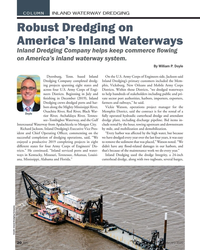 )
February 2020 - Marine News page: 20
)
February 2020 - Marine News page: 20in our harbors, and tricts.” He continued, “Inland serviced ports and water- that’s because of the maintenance work we do every year.” ways in Kentucky, Missouri, Tennessee, Arkansas, Louisi- Inland Dredging used the dredge Integrity, a 24-inch ana, Mississippi, Alabama and Florida.” cutterhead dredge, along
-
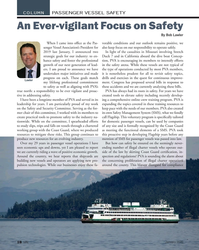 )
January 2020 - Marine News page: 18
)
January 2020 - Marine News page: 18Association’s President for also keep focus on our responsibility to operate safely. 2019 last January, I announced two In light of the casualties in Missouri involving Stretch strategic goals for our industry: to en- Duck 7 and in California aboard the dive boat Concep- hance safety and foster the professional
-
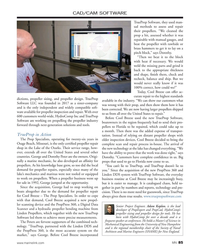 )
November 2019 - Marine News page: 85
)
November 2019 - Marine News page: 85propeller shops with The Prop Specialists, operating for twenty-six years in older inspection devices, Cool Breeze decided to bring the Osage Beach, Missouri, is the only certi? ed propeller repair complete scan and repair process in-house. The arrival of shop in the Lake of the Ozarks. Their service
-
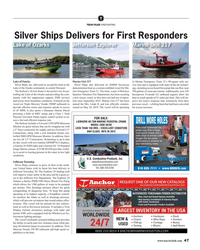 )
September 2019 - Maritime Reporter and Engineering News page: 47
)
September 2019 - Maritime Reporter and Engineering News page: 47the Silver Ships also delivered its AM800 ? re/rescue vice area and is equipped with state-of-the-art technol- Lake of the Ozarks community in central Missouri. demonstration boat as a custom out? tted vessel for Ma- ogy, including an on-board ? re pump that can ? ow near The ? reboat’s 34-foot frame
-
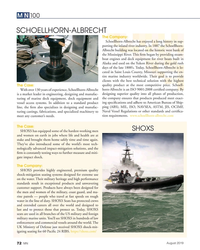 )
August 2019 - Marine News page: 72
)
August 2019 - Marine News page: 72in Alaska and used on the Yukon River during the gold rush days of the late 1800’s. Today, Schoellhorn-Albrecht is lo- cated in Saint Louis County, Missouri supporting the en- tire marine industry worldwide. Their goal is to provide clients with the best technical solution with the highest The Case:
-
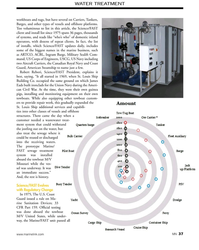 )
February 2019 - Marine News page: 37
)
February 2019 - Marine News page: 37it could be reused or discharged into the receiving waters. The prototype Marine/ FAST sewage treatment system was installed aboard the towboat M/V Missouri while the ves- sel was underway. It was an immediate success.” And, the rest is history. Scienco/FAST Evolves with Regulatory Change In 1975, The
-
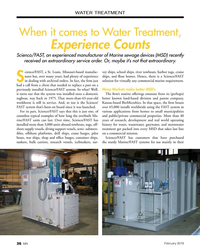 )
February 2019 - Marine News page: 36
)
February 2019 - Marine News page: 36of Marine sewage devices (MSD) recently received an extraordinary service order. Or, maybe it’s not that extraordinary. cienco/FAST, a St. Louis, Missouri-based manufac- vey ships, school ships, river towboats, harbor tugs, cruise turer has, over many years, had plenty of experience ships, and foat
-
 )
November 2018 - Maritime Reporter and Engineering News page: 50
)
November 2018 - Maritime Reporter and Engineering News page: 50to be continually successful on the acquisition quisitions. side, we have to be at about $2 billion a year. 1 2 eter, a Coast Guard 25-foot re- sippi, Missouri and Kaskaskia riv- Coast Guard Commandant Karl Coast Guard Cutter Waesche pre- sponse boat is
-
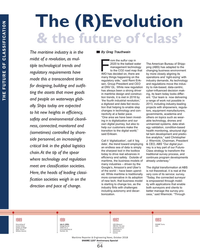 )
October 2018 - Maritime Reporter and Engineering News page: 64
)
October 2018 - Maritime Reporter and Engineering News page: 64autonomy and decar- better manage the survey pro- bonization. cess,” said Wiernicki. “Through 1989 1991 1992 1993 Grounding of July 4, 1991: USS Missouri SNAME Turns tanker Exxon Arleigh Burke (BB-63), the last 100. Valdez on Bligh (DDG 51) is active American Reef, Prince commissioned at battleship
-
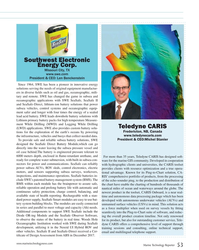 )
July 2018 - Marine Technology Reporter page: 53
)
July 2018 - Marine Technology Reporter page: 53Southwest Electronic Energy Corp. Missouri City, TX www.swe.com President & CEO: Len Benckenstein Since 1964, SWE has been a pioneer in innovative energy solutions serving the needs of original equipment manufactur- ers in diverse ? elds such as oil and gas, oceanographic, mili- tary and remote. SWE has
-
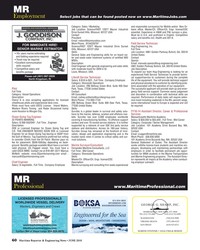 )
June 2018 - Maritime Reporter and Engineering News page: 60
)
June 2018 - Maritime Reporter and Engineering News page: 60for Mobile and/or New Or- Job Location: Scienco/FAST 12977 Maurer Industrial leans of? ce. Master/Ch. Of? cer/Ch. Engr. license/COC Drive Sunset Hills, Missouri, 63127 USA essential. Experience in H&M and P&I surveys a plus. Contact Must be in U.S. and pro? cient in English. Competitive President salary
-
 )
May 2018 - Marine News page: 44
)
May 2018 - Marine News page: 44& Transportation Industry consultant for Cater- • Would states be willing to collaborate, to split the cost of pillar Global Aftermarket Solutions, Missouri has a lot of funding a qualifying application involving a vessel that runs barge traf? c while all the waterways meet in Paducah, KY. between both
-
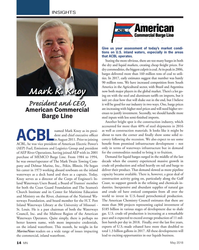 )
May 2018 - Marine News page: 14
)
May 2018 - Marine News page: 14Foundation, and board member for the H.T. Pott The American Chemistry Council estimates that there are Inland Waterways Library at the University of Missouri - more than 300 projects representing capital investment of St. Louis. He is a past chairman of both the Waterways $185 billion in various stages
-
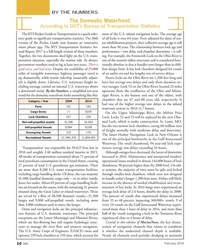 )
February 2018 - Marine News page: 10
)
February 2018 - Marine News page: 10features of U.S. domestic waterways. The principal half of the vessels navigating a lock in the Tennessee River exceptions are the Lower Mississippi and Missouri Rivers, experienced close to 4 hours of delay. which are free-? owing but still require hydrologic struc- Central to this edition of MarineNews,
